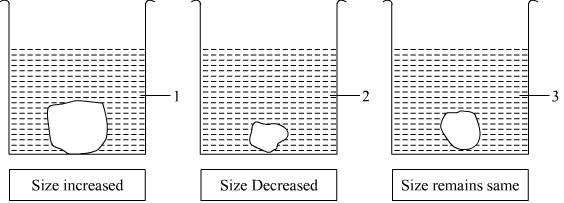Board Paper of Class 10 2014 Biology - Solutions
General Instructions:
Answer to this paper must be written on the paper provided separately.
You will not be allowed to write during the first 15 minutes.
This time is to be spent in reading the question paper.
The time given at the head of paper is the time allotted for writing the answers.
Section I is compulsory. Attend any four questions from Section II.
The intended marks of questions or parts of questions are given in brackets [ ].
- Question 1
VIEW SOLUTION(a) Name the following:
(i) The part of the brain associated with memory.
(ii) The ear ossicle which is attached to the tympanum.
(iii) The type of gene which is not expressed in the presence of a contrasting allele.
(iv) The hormone secreted by islets of langerhans.
(v) The process of conversion of ADP into ATP during photosynthesis.[5] (b) State the main function of the following:
(i) Cerebrospinal fluid
(ii) Eustachian tube
(iii) Suspensory ligament of the eye
(iv) Sperm duct
(v) Lenticels[5] (c) Copy and complete the following by filling in the blanks 1 to 5 with appropriate words:
The human female gonads are ovaries. A maturing egg in the ovary is present in a
sac of cells called ___________(1). As the egg grows larger, the follicle enlarges and gets filled with a fluid and is now called the ______________(2) follicle. The process of releasing the egg from the ovary is called _______________(3). The ovum is picked up by the oviducal funnel and fertilisation takes place in the ______________(4). In about a week, the blastocyst gets fixed in the endometrium of the uterus and this process is called ____________________(5).[5] (d) Given below are six sets with four terms each. In each set one term is odd and cannot
be grouped in the same category to which the other three belong. Identify the odd one in each set and name the category to which the remaining three belong. The first one has been done as an example.
Example: Calyx, Corolla, Stamens, MidribOdd term: midrib(i) Haemoglobin, Glucagon, Iodopsin, Rhodopsin
Category: Parts of a flower
(ii) Urethra, Uterus, Urinary bladder, Ureter
(iii) Transpiration, Photosynthesis, Phagocytosis, Guttation
(iv) Cyton, Photon, Axon, Dendron
(v) Oxytocin, Insulin, Prolactin, Progesterone[5] (e) The figure given below represents an experimental setup with a weighing machine to
demonstrate a particular process in plants. The experimental setup was placed in
bright sunlight. Study the diagram and answer the following questions:
.png)
(i) Name the process intended for study.
(ii) Define the above mentioned process.
(iii) When the weight of the test tube (A & B) is taken before and after the experiment,
what is observed? Give reasons to justify your observation in A & B.
(iv) What is the purpose of keeping the test tube B in the experimental setup?[5] (f) Match the items given in Column A with the most appropriate ones in Column B and rewrite the correct matching pairs from Column A and Column B: div Sr. No. Column A Column B 1. Pituitary gland a. Testosterone 2. Sulphur dioxide b. Calcium 3. Seminiferous tubules c. Growth hormone 4. Clotting of blood d. Acid rain Guttation e. Sperms f. Global warming g. Magnesium h. Hydathodes [5] (g) Choose the correct answer from the options given below:
(i) Cretinism and Myxoedema are due toA. Hypersecretion of thyroxin
B. Hypersecretion of growth hormone
C. Hyposecretion of thyroxin
D. Hyposecretion of growth hormone
(ii) Which of the following is not a natural reflex action?A. Knee-jerk
B. Blinking of eyes due to strong light
C. Salivation at the sight of food
D. Sneezing when any irritant enters the nose
(iii) After mitotic cell division, a female human cell will haveA. 44 + XX chromosomes
B. 44 + XY chromosomes
C. 22 + X chromosomes
D. 22 + Y chromosomes
(iv) The antibiotic penicillin is obtained fromA. Protozoan
B. Bacteria
C. Virus
D. Fungus
(v) The site of maturation of human sperms is theA. Seminiferous tubule
B. Interstitial cells
C. Epididymis
D. Prostate gland[5] (h) State the exact location of the following:
(i) Tricuspid valve
(ii) Amnion
(iii) Yellow spot
(iv) Seminal vesicle
(v) Adrenal gland[5]

.png)

.png)
.png)
.png)